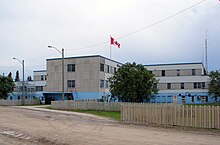
James Bay is a large body of water located on the southern end of Hudson Bay in Canada. Both bodies of water extend from the Arctic Ocean, of which James Bay is the southernmost part. It borders the Canadian provinces of Quebec and Ontario. Islands within the bay, the largest of which is Akimiski Island, are part of Nunavut.
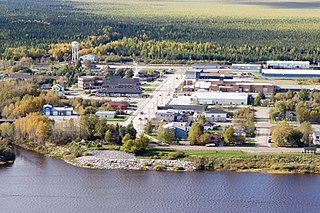
Moosonee is a town in northern Ontario, Canada, on the Moose River approximately 19 kilometres (12 mi) south of James Bay. It is considered to be "the Gateway to the Arctic" and has Ontario's only saltwater port. Nearby on Moose Factory Island is the community of Moose Factory to which it is connected by water taxi in the summer and ice road in the winter.
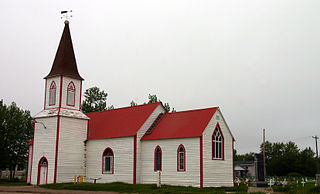
Moose Factory is a community in the Cochrane District, Ontario, Canada. It is located on Moose Factory Island, near the mouth of the Moose River, which is at the southern end of James Bay. It was the first English-speaking settlement in lands now making up Ontario and the second Hudson's Bay Company post to be set up in North America after Fort Rupert. On the mainland, across the Moose River, is the nearby community of Moosonee, which is accessible by water taxi in the summer, ice road in the winter, and chartered helicopter in the off-season.

Fort Albany First Nation is a Cree First Nation reserve in Cochrane District in Northeastern Ontario, Canada. Situated on the southern shore of the Albany River, Fort Albany First Nation is accessible only by air, water, or by winter road.

The Attawapiskat First Nation is an isolated First Nation located in Kenora District in northern Ontario, Canada, at the mouth of the Attawapiskat River on James Bay. The traditional territory of the Attawapiskat First Nation extends beyond their reserve up the coast to Hudson Bay and hundreds of kilometres inland along river tributaries. The community is connected to other towns along the shore of James Bay by the seasonal ice road/winter road constructed each December, linking it to the towns of Kashechewan First Nation, Fort Albany, and Moosonee Attawapiskat, Fort Albany, and Kashechewan operate and manage the James Bay Winter Road through the jointly owned Kimesskanemenow Corporation, named after the Cree word for "our road" -kimesskanemenow. Attawapiskat is the most remote northerly link on the 310-kilometre-long (190 mi) road to Moosonee. They control the reserves at Attawapiskat 91 and Attawapiskat 91A.

A paramedic is a healthcare professional, providing pre-hospital assessment and medical care to people with acute illnesses or injuries. In Canada, the title paramedic generally refers to those who work on land ambulances or air ambulances providing paramedic services. Paramedics are increasingly being utilized in hospitals, emergency rooms, clinics and community health care services by providing care in collaboration with registered nurses, registered/licensed practical nurses and registered respiratory therapists.
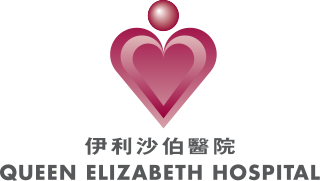
Queen Elizabeth Hospital, QE or QEH in short, is one of the largest acute general hospitals in Hong Kong. It was named after Queen Elizabeth II. The hospital is a major tertiary hospital in southern Kowloon, with over 1,900 beds. It employs more than 500 physicians and surgeons.

The Kashechewan First Nation is a Cree First Nation band government located near James Bay in Northern Ontario, Canada. The community is located on the northern shore of the Albany River. Kashechewan First Nation is one of two communities that were established from Old Fort Albany in the 1950s. The other community is Fort Albany First Nation, which is now located on the southern bank of the Albany River. The community is connected to other towns along the shore of James Bay by the seasonal ice road/winter road, linking it to the towns of Attawapiskat, Fort Albany, and Moosonee.

Thunder Airlines is a Canadian scheduled flight, charter and medevac airline based in Thunder Bay, Ontario. It offers an on-demand charter service from bases in Thunder Bay and Timmins. The company was founded in 1994 and operates fourteen aircraft and flies to six destinations regularly.

Peawanuck is an isolated Cree community in the Kenora District, Ontario, Canada. It is located near the confluence of the Winisk and Shamattawa rivers, about 35 km from the Winisk River's end in Hudson Bay. Its population is 237.

NORTH Network was a telehealth organization serving communities in Northern and Central Ontario. NORTH's head office was located in Toronto and its clinical headquarters in Timmins. NORTH was a program of Sunnybrook Health Sciences Centre, and received funding from the provincial government's Ministry of Health and Long Term Care.

The Hudson Bay Lowlands is a vast wetland located between the Canadian Shield and southern shores of Hudson Bay and James Bay. Most of the area lies within the province of Ontario, with smaller portions reaching into Manitoba and Quebec. Many wide and slow-moving rivers flow through this area toward the saltwater of Hudson Bay: these include the Churchill, Nelson and Hayes in Manitoba, Severn, Fawn, Winisk, Asheweig, Ekwan, Attawapiskat, and Albany in Ontario, and the Harricana, Rupert and Eastmain in Quebec. This is the largest wetland in Canada, and one of the largest in the world. The region can be subdivided into three bands running roughly northwest to southeast: the Coastal Hudson Bay Lowland, Hudson Bay Lowland, and James Bay Lowland.

John Horden was the first Anglican Bishop of Moosonee, Canada, who for more than forty years led services in Cree, Inuit and other languages of his parishioners.

UW Health University Hospital is a 505-bed academic regional referral center with 125 outpatient clinics, located on the western edge of the University of Wisconsin–Madison's campus in Madison, Wisconsin. It is an American College of Surgeons designated Level I adult and pediatric trauma center, one of only two in Wisconsin. UW Health University Hospital has seven intensive care units. UW Health University Hospital was ranked by U.S. News & World Report as the 17th best hospital in the United States and the #1 hospital in Wisconsin in the publication's 2019-2020 Best Hospitals Honor Roll, earning national rankings in 12 adult and 4 pediatric specialties. Additionally, UW Health University Hospital was ranked as the 14th best hospital in the United States and among the top 100 hospitals in the world by Newsweek in 2019.
Spartanburg Regional Healthcare System(SRHS) is one of South Carolina's largest healthcare systems. SRHS draws patients primarily from the areas of Spartanburg, Cherokee, Union and Greenville counties, located in the Piedmont region of South Carolina, and Rutherford and Polk counties, located in western North Carolina. Spartanburg General Hospital was organized under the authority of the South Carolina General Assembly in 1917, and officially became the Spartanburg Regional Health Services District, Inc., a political subdivision of the State of South Carolina, by charter granted by the secretary of state of South Carolina on May 1, 1995.
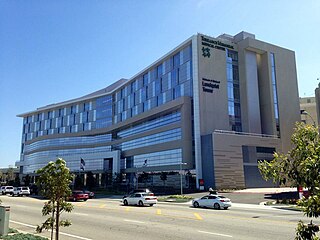
Torrance Memorial Medical Center is a private hospital located in Torrance, California. Torrance Memorial Medical Center is a Magnet designated facility recognized by the American Nurse Credentialing Center (ANCC) for quality patient care, nursing excellence and innovations in professional nursing practice. Torrance Memorial was the first hospital in the Los Angeles South Bay region, and is currently one of just three burn centers in Los Angeles County.

Moose Factory Island is an island in the Moose River, Ontario, Canada, about 16 kilometres (10 mi) from its mouth at James Bay. It is adjacent to the community of Moosonee across the Moose River, from which it is accessible by water taxi. The island is home to the community of Moose Factory. This town is associated with the entire island, but politically, the island is divided into two entities:

Medicine Hat Regional Hospital is a medical facility located in Medicine Hat, Alberta serving a catchment area of 117,000. It has 325 beds.
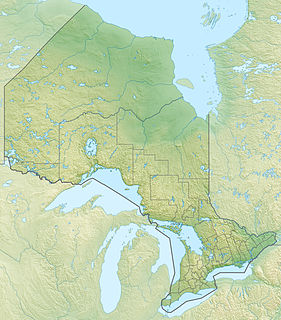
The Kapiskau River is a river in the far northeast of Kenora District in Northwestern Ontario, Canada. It is a tributary of James Bay.
Weeneebayko Area Health Authority Paramedic Services (WAHA-PS) - formerly James Bay Ambulance Services - services First Nation communities in Northern Ontario and is funded by the province of Ontario.
